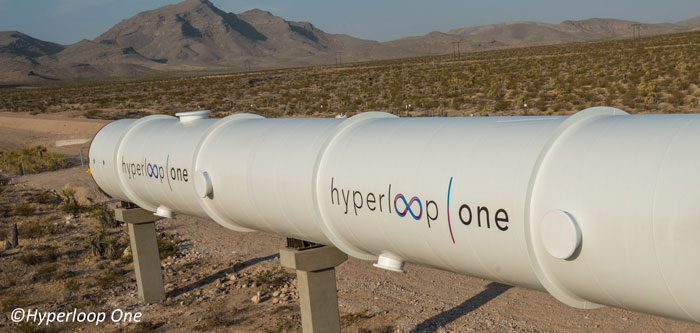
Hyperloop One has agreed a deal with the Dubai Road Transport Authority to assess the delivery of a hyperloop system that will reduce the time taken to travel from Dubai to Abu Dhabi.
The system which works using a vacuum-sealed pod transport system could potentially reduce the time taken to travel the 90 miles from Dubai to Abu Dhabi in as little as 12 minutes. Whilst initially the aim is to concentrate on what a hyperloop system can achieve across the United Arab Emirates (UAE), there is speculation that it could be expanded at a later date to build links with neighbouring Gulf countries. The current travel time by plane between Dubai and Saudi Arabia is 2 hours; with Hyperloop that travel time could be halved.
There are no specific timescales published for the study or the implementation of the system, but Hyperloop chief executive Rob Lloyds is reported as saying that “from a technological point of view, we could have a Hyperloop One system built in the UAE in the next five years”.
What is Hyperloop?
Hyperloop is a new way of transporting people and cargo as fast as or faster than airline speeds but at the lower cost of ground transport systems like buses. Electric motors control levitated pods through low pressure tubes allowing them to glide along without the effects of turbulence.
The system motors were tested in May this year and it is hoped that a full system will be available for testing in 2017. The ultimate goal is to be using Hyperloop systems to move cargo by 2020 and passengers by 2021.
The project began in 2014 and now has a team of more than 200 engineers, mechanics, designers, machinists, welder and builders based at 3 campuses in Los Angeles and Nevada. It has attracted funding from various sources and has worldwide interest with many countries already considering the impact it could have on journey times between major cities.
What would it be like to ride the Hyperloop?
At the moment, the reality is unknown, but the concepts and ideas are in full flow. Instead of having to get to an airport hours before your flight or be crammed into a full rail carriage, the vision is for a smooth, relaxed, reasonably priced, quick journey that can be taken on demand.
Pods would be able to carry up to 100 people and be spacious allowing room for freedom of movement or to work comfortably during a journey. It is suggested that companies could buy their own pods and customise them for use and health providers may use them for critical patient transfers. If using the general public transport element you would be able to call a pod to your docking station to take you directly to your destination rather than travelling a set route stopping at stations along the way.
Taken a step further, there is a vision of autonomous vehicles being hailed to collect you and deliver you to your docking station, perhaps even driving in to the pod at one end and driving out at the other to deliver you on to your final destination.
Whilst on the face of it, some of the vision sounds a little too futuristic especially when you consider some of the issues around autonomous vehicles on public roads. But setting those aside, a low cost, fast, effective method of travel may well be on the cards in the not too distant future.
If you want to read more about Hyperloop One, visit their website.
This site uses Akismet to reduce spam. Learn how your comment data is processed.


 Mail:
Mail: 




Leave a Comments